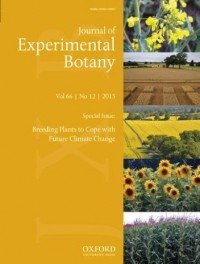Journal of Experimental Botany Q1 Unclaimed
The aim of Journal of Experimental Botany (JXB) is to publish papers that advance our understanding of plant biology. Original research should provide new information on fundamental processes or mechanisms including those underpinning the improvement of plants for the sustainable production of food, fuel and renewable materials. When considering if a paper is suitable, consideration will be given to the breadth and significance of the work to the plant science community. It has an SJR impact factor of 1,778.
Journal of Experimental Botany focuses its scope in these topics and keywords: plant, cell, wheat, water, root, wood, useefficient, tobacco, tissue, structure, ...
Type: Journal
Type of Copyright:
Languages: English
Open Access Policy:
Type of publications:
Publication frecuency: -


- €
Inmediate OANPD
Embargoed OA- €
Non OAMetrics
1,778
SJR Impact factor308
H Index481
Total Docs (Last Year)1614
Total Docs (3 years)40009
Total Refs9962
Total Cites (3 years)1596
Citable Docs (3 years)5.62
Cites/Doc (2 years)83.18
Ref/DocOther journals with similar parameters
Circulation Q1
Annual Review of Plant Biology Q1
Annual Review of Physiology Q1
Nature Metabolism Q1
Circulation Research Q1
Compare this journals
Aims and Scope
Best articles by citations
Leaf Senescence: Correlated with Increased Levels of Membrane Permeability and Lipid Peroxidation, and Decreased Levels of Superoxide Dismutase and Catalase
Gene networks involved in drought stress response and tolerance
Drought, salt, and temperature stress-induced metabolic rearrangements and regulatory networks
ROS as key players in plant stress signalling
The interaction of plant biotic and abiotic stresses: from genes to the field
Elevated CO2 effects on plant carbon, nitrogen, and water relations: six important lessons from FACE
Approaches to increasing the salt tolerance of wheat and other cereals
Chlorophyll fluorescence analysis: a guide to good practice and understanding some new applications
Deficit irrigation for reducing agricultural water use
Housekeeping gene selection for real-time RT-PCR normalization in potato during biotic and abiotic stress
Cereal seed storage proteins: structures, properties and role in grain utilization
Breeding for micronutrients in staple food crops from a human nutrition perspective
The significance of amino acids and amino acid-derived molecules in plant responses and adaptation to heavy metal stress
Salicylic acid beyond defence: its role in plant growth and development
The challenge of improving nitrogen use efficiency in crop plants: towards a more central role for genetic variability and quantitative genetics within integrated approaches
Recent advances in the transcriptional regulation of the flavonoid biosynthetic pathway
Involvement of soluble sugars in reactive oxygen species balance and responses to oxidative stress in plants

Comments